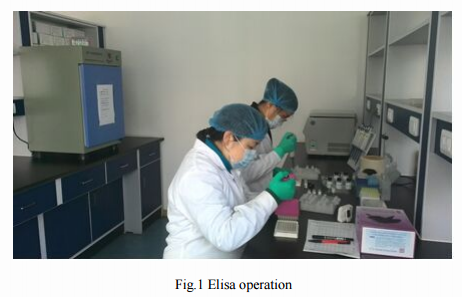Why the samples′ OD is low in Elisa
In ELISA experiments, researchers often encounter samples with low OD, including serum, plasma, tissue homogenate, cell lysate, etc. Assuming the customer's operation is right, the standard curve is also good, in this situation the reasons can be analyzed in two ways. On one hand, the content of the sample itself can be detected, but some operations cause the samples measured value become out of the detection range of Elisa kit; On the other hand, low concentration of analyte in the sample itself. Following we’ll analyze in these two aspects and raise their solutions.

1. When the content of target molecules itself can be detected, what factors may cause low measured value?
1) Reagents storage
The Elisa kits should be stored according to the method prescribed in the manual. E.g. kits from USCN, the Standard, Detection Reagent A, Detection Reagent B and the 96-well strip plate should be stored at -20 degree upon receipt while the others should be at 4 degree.
2) Sample preparation and storage
The preparation consists of sample preparation, storage and whether experienced repeated freezing and thawing.
Samples preparation: It varies with sample types, serum, plasma and cell lysates, so they must be prepared in different ways.
Storage: including storing temperature and time. Usually it’s recommended to store samples in aliquot at -20 or -80 degree, the storage time should not be too long, because prolonged storage may lead to degradation of the target molecules, resulting in uncorrect testing results. Finally, please be ensure not to repeat freezing and thawing, this may cause the degration of target molecules, too.
3) Dilution scheme
The dilution scheme is critical to Elisa, exceeding dilution as well as inadequate dilution are both likely to lead to low measurement value.
Exceeding dilution: Usually customers will estimate a dilution fold based on reference value in literatures and the detection range of Elisa kit . Cloud-Clone Corp. also has done a lot of testing before shipment, For conventional samples, such as serum and plasma, it will show a recommending dilution fold on the basis of our laboratory values in the manual. However, if experimenters verify samples dilution scheme just by reference or recommendation, sometimes researchers got very low sample OD. This is because the samples from literature, Cloud-Clone Corp. and experimenters are different, The values should only be thought as reference, otherwise it may result in failure in experiments. Consequently it’s strongly recommended to have a pilot experiment to verify the samples’ validity and optimal dilution scheme before formal experiments. In the preliminary experiment, researchers can make a gradient dilution refer to literatures or Elisa kit manufacture’s recommendation, and finally determine a dilution scheme by the samples’ OD which falls in the middle of the standard curve.
Inadequate dilution: Hook Effect, in Elisa experiments hook effect occurs mainly when the ratio of antigen and antibody is inappropriate and lead to false negative phenomenon, it’s called after banding effect when the antigen is much more. When the content of the target protein is high but with improper dilution, it may cause false negative reactions. Its solution—a pilot experiment before formal experiment.
2. Low analyte concentration in samples
In many cases, there is no problem in the operation, and the standard curve is good, but samples are out of detection range even repeating, such as cytokines, e.g. IL-6 will only be produced in inflammation circumstances, non-inflammatory samples have very low concentration. In this case, it’s suggested to choose sample type according to literatures or choose the high sensitivity Elisa kit. In addition, Cloud-Clone Corp. has developed high sensitivity Elisa kits aiming some molecules whose baseline may be relatively low.
Overall, a successful experiment depends on qualified Elisa kits, proper samples, and good operation.
For more information, please see http://www.cloud-clone.us/.
